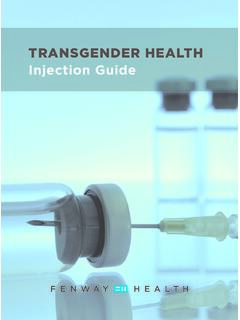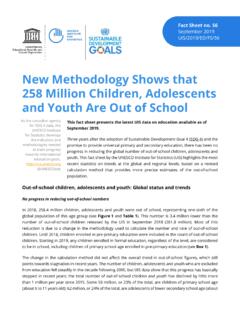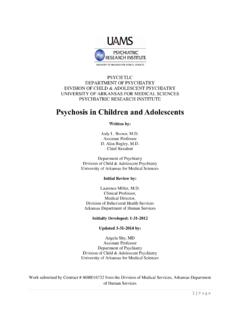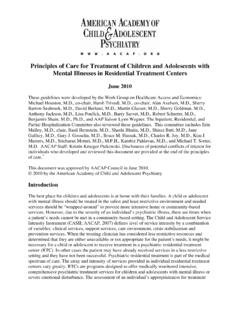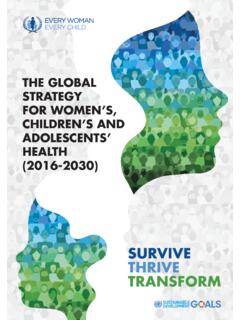Transcription of Gender Identity Development in Children and Adolescents
1 Gender Identity Development in Children and AdolescentsMichelle Forcier, MD, MPHA ssociate Professor PediatricsDivision adolescent Medicine, Alpert School of MedicineBrown UniversityContinuing Medical Education Disclosure Program Faculty: Michelle Forcier, MD MPH Current Position: Pediatrician, adolescent Medicine Provider, Hasbro Children s Hospital, and Associate Professor of Pediatrics, Warren Alpert Medical School of Brown University Disclosure: Consultant: Merck and PPLM. Hormone therapy for transgender patients is not currently FDA ,FenwayHealththatallCMEplanningcommittee /faculty/authors/editors/staffdisclosere lationshipswithcommercialentitiesuponnom ination/invitationofparticipation.
2 Disclosuredocumentsarereviewedforpotenti alconflictsofinterestand,if identified,theyareresolvedpriortoconfirm ationofparticipation. We Are3 Natal or biologic Gender Brain, hormones, body parts assigning male/female Gender , usually at birth Gender Identity Person s basic sense of being male or female, especially as experienced in self-awareness and behavior Gender expression Ways in which a person acts, presents self & communicates Gender within a given We Love4 LGBTQQI Lesbian, Gay, Bisexual, Transgender, Queer, Questioning, Intersex YMSM Young Men who have Sex with Men YWSW Young Women who have Sex with Women Bisexual, pansexual, asexual, queer1-d(isease) Model5 Deviation = Disease & Pathology Disease Diagnose Treat or Fix Stigmatize Shame, isolation Bias, discriminationPsych testingDSM diagnostic criteriaMeeting guidelinesReal life experienceGatekeeping model to servicesHow can Children know?
3 What if we make a mistake?What if they get hurt? Change their mind? Can t find love?Why not wait?2d-Spectrum Model6 Biologic GenderGender Identity & ExpressionSexualAttraction, Orientation, BehaviorsMaleFemaleMasculineFeminineGyno philicIntersexXYXXA ndrogynousAndrophilicCisgenderNon-Binary Approach7 MaleFemaleMasculineFeminineGynophilicInt ersexXYXXA ndrogynousAndrophilicGenderqueerPansexua lAssigned GenderGender Identity & ExpressionSexualAttraction, Orientation, BehaviorsDiane Ehrensaft sGender Web8 Searching, creating, editing fabric of one s authentic self = Gender HEALTH! Weaving over time various interconnected threadsEarly Gender Development Awareness of Gender Identity9 Between ages 1 and 2 Conscious of physical differences between gendersAt 3 years oldLabel themselves as girl or boyBy age 4 Gender Identity is often stableRecognize that Gender is constantGender Play10 Allpre-pubertal Children play with Gender expression & roles Passing interest or trying out Gender -typical behaviors Interests related to other/opposite sex Few days, weeks, months, years Gender Nonconforming Cross Gender expression, role playing Wanting other Gender body/parts Not liking one s Gender & body ( Gender dysphoria)
4 Agender Non binary Refusesto ascribe to typical masculine or feminine assignmentsPersistent, consistent, insistent Fluid, nonconforming1112 She never wanted to wear dresses. He liked to play with dolls and dress up with his sisters. She always wanted to have her hair cut short. He did not want to join little league like his brother did. All her friends are boys. 13 S/he was always a little different than peers, even as early as in preschool or kindergarten. He drove his father crazy by never wanting to join his brothers outside but instead playing with his sister and her friends. She told me in first grade that she was a boy. He wanted to grow his hair long and wear jewelry.
5 She adamantly refused to wear a dress to her aunt s wedding. He wanted to be in the school play in the role of Cinderella. School Norms14 At 5-6 up on rules Sensitive to adult explicit & implicit messages What is accepted, rewarded, valued At 7 constancy Independent of external feature Loss of magical thinking about body, Gender possibilitiesGoing Underground15 Suppress cross Gender activities Move to secretive thoughts, feelings, behaviors Avoid distressing parents, criticism in social settings ..Thoughts, feelings still existScreening & Early Identification16 How to screen Interventions Understanding outcomesWho to Screen?17 All Children Developmental stages Non-conforming expression Concerns/problems with Mood Behavior SocialComing Out TransgenderPatientsMean,(Age Range)Assigned Femaleat BirthAssigned Male at BirthAge of (4-20) (6-20) (4-20)Tanner (1-5) (1-5) (1-5)To t a ln, (%)97 (100)54 ( )43 ( )SpackN, GeMSClinic, Boston Children s Hospital.
6 Pediatrics, 2012 18 TransYouth Project Large-scale (>150 Children ) longitudinal study of transgender Children in 25 states 2015 - childhood transgender identities are as deeply rooted as cispeers 2016 - 73 Children , age 3-12 NIH Patient Reported Outcome Measurement Information System Symptoms of depression or anxiety during past week Rates depression ( ) and anxiety ( ) no higher than 2 control groups -- their own siblings & cisage- and Gender -matched Children Significantly lower than those of Gender -nonconforming Children in previous studiesOlson KR, DurwoodL, DeMeulesM, et al. Mental Health of Transgender Children Who Are Supported in Their Identities. Pediatrics. 2016;137(3):e2015322319 Nonconformity Bias & Bullying 202015 YRBSLGB students 10% threatened or injured with weapon on school property 34% bullied on school property 28% bullied electronically 23% sexual dating violence in prior year 18% physical dating violence 18% forced to have sex at some point in their Negative Effects YRBS 201521 Exposure to violence health disparities LGB students 140% (12% v.)
7 5%) more likely to not go to school at least one day during 30 days prior because of safety concerns Absenteeism linked to low graduation rates, SES impact 29% LGB youth attempted suicide at least once prior year compared to 6% of heterosexual youth 2014, YMSM 80% HIV diagnoses among youth22 Prejudice, Discrimination, AbuseLack of AcceptanceIsolation, Esteem, ResourcesStigmaMinority StressAnxietyDepressionSuicide Substance useSES disadvantageVictimizationGender or sexual minority(any social minority status)Social = Deviant23 Internalize societal phobiaDecreased sense of self-worth Guilt, ShameSelf-medicationSubstance abuseIsolation, Lack social support & connectednessRisk-taking behaviorSuicidalityWithout Systemized Many youth eventually wind up getting into medical care after multiple instances of mental health problems School failure Mood & behavior problems Substance use/abuse Child abuse, victimization Self harm, suicidality Out & inpatient psychiatric careSchneebergerAr2014, SchneedbergerAR 2014, Clark TC2014, Simons L 2013.
8 Robinson JP 2013 Risk Behaviors MTF Youth25 Health Risk BehaviorTRANS YouthCISY outhAlcohol use23%17%No condom at last sex51%38%Depressive symptoms58%21%Self-harm past year54%14%Suicidal Ideation 20%61%Physical bullyingRelational bullyingPrejudice-based reason: genderPrejudice-based reason: Gender expression25%52%35%47%12%32%5%15%Eisenbe rg, Gower, McMorris, Rider, Sheaand Coleman. J AdolescHealth 2017. Student Survey 9thand 11thgraders, n=81,885 Trans/genderfluid/non-conforming n=2,168 ( ) Risk behaviors significantly higher among trans than cis Emotional distress, bullying significantly more common among birth-assigned females than males Protective factors: Family connectedness Student-teacher relationships Feel safe in communityHow to Screen26 Ask!
9 Parent(s) Child play, hair, dress preferences Parent concerns with these Concerns re: behavior, friends, getting along at school, school failure, bullying, anger, sadness, isolation, other??? Ask! Child Do you feel more like a girl, boy, neither, both? How would you like to play, cut your hair, dress? What name or pronoun (he for boy, she for girl) fits you?27 Ask provider role- Nothing to fix .. encourage & support- Parents accepting, allowing child to be, loving child as is - Ongoing relationship(s) for support & interventionGender Play- Passing interest or trying out behaviors, activities, clothes & roles-Shared characteristics but does not want to be other genderGender Nonconformity- Persistent, consistent, insistent- Desire to be other Gender - Dysphoriaabout body & genderRange of Treatment Approaches29 Allow some experience puberty, to age 15-16 or Tanner 4, then start GnRHanalogues or hormones Gender Identity stable, criteria met Start GnRHanalogues at Tanner 2 Initiate hormones several years laterLiving in Asserted Gender Gender Identity stable.
10 Criteria met Initiate puberty with hormonescongruent with Gender identityNo treatment until 18(after full pubertal experience) GCSE arlier is BetterEarly, strong social support & plan Multiple studies demonstrate family & parent support critical to positive health outcomesEarly medical & mental health resources Experience puberty congruent with Gender Avoid psychological stress-anxiety, depression Prevent unwanted 2nd sex characteristics Reduce need for future medical interventions30 Early Social Transition31 Assuming cross Gender expression to match Identity Multiple or all social settings Reversible, cosmetic Well planned & supported Safety!! Considerations & preparation Trial run see how it feels, how child responds Specifics- name, pronoun, restrooms, locker rooms, sleep-overs Disclosure or not.

